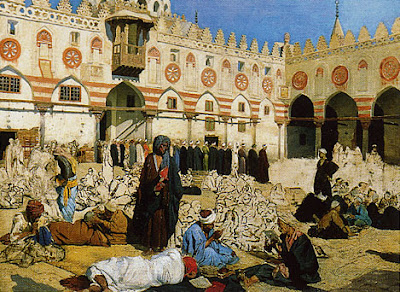Artist: Ludwig Deutsch
Title: The Learned (l'Érudit), 1901
Signed lower left L. Deutsch 1901
Medium: oil on panel/huile sur panneau
Size: 100.3x71cm
Orientalist Paintings by Ludwig Deutsch and Commentary on his work



In the present painting Deutsch is at the height of his powers. The figure of the guard exudes pride and grandeur and his pose in unyielding and commanding. This same figure appears in another work that bears the same title from 1900, which is currently in the Nadj Collection. A number of Deutsch's favorite props, such as the Indo-Persian helmet and shield as well as the exquisitely embroidered green silk fabric, appear in both compositions.
A study for the present painting illustrates the astonishingly exact and detailed planning involved. Deutsch produced many sketches and color studies before moving forward with a composition, and it is apparent that with each stage of planning and execution he aimed for perfection.
Deutsch's use of architecture is similar to a stage set, as it utilizes to help reinforce the human figure. In his composition of the palace guard, Deutsch frequently used columns, gateways, exquisitely worked masonry and marbles to accentuate the might and glory of his sitters.
Source Christie's Catalog New York April 2006, p. 36
The intensely detailed depiction of the guard enhances by his isolated framing produce a psychologically penetrating image. By capturing the slightly quizzical element to his expression, Deutsch conveys the nobility, strength and grace that were the essence of a palace guard. As the light glimmers on his mighfar's chain mail, the Persian brass shield leaning against the white marble column and reflects across the gold and the pink silks of his garments, it also highlights his full lips and illuminates his richly dark skin. The glorious combination of the guards majestic posture enhanced by luscious textiles, powerful and glittering armor enveloped by a spectacular Andalusian double arched entrance is an evidence of Deutsch's astounding dexterity.
Source: P. Cruysmans, Orientalist Painting, Brussels 1982, p. 115 and Christies New York October 2001 catalog p. 68

In Morning Prayer there are some compositional similarities with his earlier paintings of palace guards. The apparent and expressive focal points, such as the red Turkish babouches, the 19th Century northwestern Persian carpet, the Syrian lamp and the mother-of-pearl inlaid kursi are all archetypal elements of Deutsch's painting. Furthermore the juxtaposition of the wine red sash against the cadmium red striped silk robe (aba) of the standing figure, set against his brilliant white turban is masterfully balanced against the massive size of the Ptlomaic granite pillar. Together with the figure depicted praying in elaborate costume, another man in very humble attire is seen meditating to the side. The abscense of a spatial hierarchy as well as one religious ceremony that all members follow simultaniously is in line with a mosque's essential function as a provider of shelter for congregational prayer. Source M. Haja and G. Wimmer, Les Orientalistes des Ecoles Allemande et Autrichienne, Paris, 2000, p. 200 and Chriestie's New York 2001 p. 40


Deutsch uses the entrance set deep into the mosque's edificeo frame the group of figures leaving, while the inky shadow of the interior contrasts with the sunlit exterior. Their costumes, like the intricate carvings along the walls, are captured in brilliant detail and stand out in complimentary res and greens. Source: Chritie's Catalog, London June 2007

